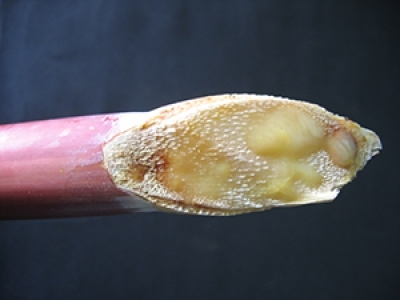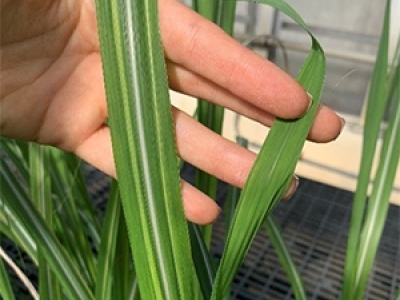Sugarcane Diseases: Gummosis and Leaf Scald

Gummosis and leaf scald can cause severe damage in sugarcane and other plants in the Poaceae family. The bacterium Xanthomonas axonopodis pv. vasculorum causes gummosis and the bacterium Xanthomonas albilineans causes leaf scald. These diseases are not widely prevalent in the United States.
Gummosis primarily attacks sugarcane, but can also affect corn, Guatemala grass, broom bamboo, hurricane palm, royal palm, and nut palm. Leaf scald can cause severe damage in sugarcane and corn intercropped with sugarcane. Globally, other countries have reported the presence of one or both diseases.
APHIS establishes quarantines (138.47 KB) and restricts the interstate movement of regulated articles (136.87 KB) to prevent the spread of these diseases in this country.
Gummosis
Gummosis causes two distinct symptoms in sugarcane plants. Mature leaves develop longitudinal stripes or streaks that are 3-7 mm in width and several centimeters in length. The stripes appear around the affected veins and near the tip. Initially the stripes are pale yellow in color and later turn brown. The affected tissues slowly dry up.
Infected canes are stunted with short internodes giving them a bushy appearance. When stunted canes are cut, a dull yellow bacterial ooze (gum) comes out from the cut ends. The vascular bundles are deep red.
Leaf Scald
The most common symptom of leaf scald is a white line about 1–2 mm wide (also called a pencil line) on the leaf. This line extends from the midrib to the leaf margin running parallel to the veins. A diffuse yellow border of varying widths runs parallel to the pencil line. The pencil line may have areas of reddish discoloration along part of its length. As the disease progresses, brown, dead tissue (necrosis) develops from the leaf tip or leaf margin and eventually extends the entire leaf. Leaves look burned and curl inward, giving them a scalded appearance–hence the disease's name. Ultimately, the entire plant dies.
Photo Gallery
View images of gummosis and leaf scald.



Sugarcane leaves with yellow stripes typical of gummosis. Photo courtesy of Mauritius Sugarcane Industry Research Institute, MCIA.
Yellow gum oozes from the cut portion of the stalk. Photo Courtesy of Mauritius Sugarcane Industry Research Institute, MCIA.
Pencil line symptoms of leaf scald. Photo courtesy of Dr. Sushma Sood, Research Plant Pathologist, USDA-ARS Sugarcane Field Station, Canal Point, Florida.
APHIS restricts the interstate movement of sugarcane plants and seeds to prevent the spread of these diseases to the continental United States (7 CFR 301.87). Sugarcane plants from other countries must first go through an intensive, 3-year post-entry quarantine to make sure they're disease free before they can be planted in the United States.
Growers can help prevent these diseases by using plants that are resistant to the Xanthomonas bacterium and planting disease-free cuttings. You can also:
- Remove volunteer and susceptible plants or plant parts
- Use sanitation practices, including regularly cleaning equipment that comes in contact with plants
There is no treatment that fully eliminates these diseases.
Report Plant Pests and Diseases
Have you seen this pest or signs of pest damage? Immediately report your findings.
Find your State plant regulatory official
Find your State plant health director




